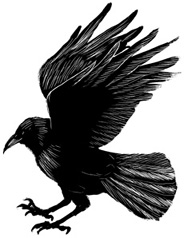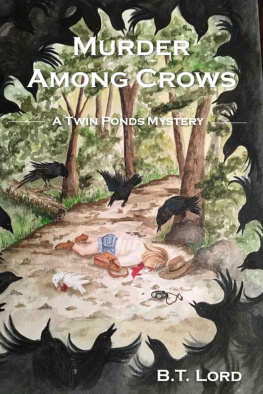Acknowledgments

Marzluffs students, postdoctoral fellows, and colleagues helped us view the crows world. Rick Knight and David Hutchinson kept our early focus on crows. Marco Restani introduced us to ravens in Greenland. Gier Sonerud, Dieter Glandt, and Michael Abbs helped us understand European crows. Erik Neatherlin, John Luginbuhl, and Jeff Bradley showed us the canopy and exposed the lives of rainforest crows and ravens. Scott Derrickson, Peter Harrity, Laura Landon, and Kate Whitmore taught us about reintroduction. Stacey Vigallon helped us see nests from a jays eye. Bob Reineke, John Withey, Bill Webb, Kara Whittaker, Thomas Unfield, and Stan Rullman read the entire manuscript, checking our science. Ellen West scrutinized the manuscript and tracked down leads to literature in cyberspace and numerous libraries. Sharon and Vince Penn told us about Quileute ways. Gene Hunn, Scott Derrickson, Tino Aguon, Rob Fleischer, Robert Askins, Reiko Kurasawa, Hito Higuchi, Cynthia Sims Parr, Ed Murphy, Steve Emslie, Uli Reyer, Hussein Isack, Richard Connor, and Jay Nelson checked our reasoning, updated our information, and made their unpublished research freely available. Rene Drake, Kevin Grigsby, Bob Ricci, Reid Hargis, Beth Wapelhorst, Lee Bond, Ed Bessetti, Dave Manuwal, and Gordon Bradley shared with us their personal encounters with crows. Linn Catlett, Dave Peterson, Ivan Eastin, Jim Agee, Steve West, Colleen Marzluff, Tina Blewett, Fred Lohrer, Stuart Houston, Jeanne Shepard, and Paul Boardman pointed us to fascinating literature and always encouraged our curiosity. Eric Shulenberger, Burt Lewis, Robert Askins, and two anonymous reviewers checked our prose and reasoning.
Eric Sorensen led us through journalism boot camp and graciously edited the entire manuscript. He inspired us with his writing and interest in crows and ravens. We will never look at buts, parentheses, and tri-syllabic words in the same way again, thanks to Eric.
Jean Thomson Black encouraged, edited, and broadened our appreciation for crows. Along with her colleagues at Yale University Press, Laura Jones Dooley, Molly Egland, Laura Davulis, and Heidi Downey, she painlessly and efficiently clarified our thoughts and improved our writing.
Russ Balda and Bernd Heinrich kindled, encouraged, directed, focused, and honed our investigations on corvids. They have always been eager to listen to, critique, and discuss our ideas. Thanks, too, to Boria Sax, Lynne Grinstein, Bill Holm, Les Perhacs, and Thomas Quinn, who opened doors and shared historical insights and field notes that gave greater authenticity and vitality to our narrative and drawings. Ivan and Carol Doig provided their usual high standard of narrative and illustrative expectation and encouragement that helped us maintain the necessary stamina to complete what we set out to do.
Much of our research was supported by the National Science Foundation, University of Washington, Olympic National Park, Olympic Natural Resources Center, Pacific Northwest Forest Sciences Laboratory, Rayonier, United States Fish and Wildlife Service, Sustainable Ecosystems Institute, and Washington State Department of Natural Resources.
Colleen, Lee, Zoe, Danika, Gavia, Larka, Bryony, and Gilia, our wives and children, have supported us at every step. They ate crow, chased crow, watched crow, caught crow, drew crow, enjoyed crow, read crow, and collected crow. But never tired of crow. They excused our numerous absences and distracted ways during the years of writing.
We thank you all for your time, interest, and inspiration. May you see crows in groups of twelve directly above you at sunset.
Overleaf: Sighting twelve crows at sunset foretells good fortune

Appendix 1

Making Observations to Learn More
Unless you live in South America or Antarctica, you probably live with some crow or raven species. You and your familys day-to-day interactions with these birds can help us all better understand our unique relationship with crows. So we invite you to challenge, probe, and test our assertions about crows and people by engaging in careful study of these amazing birds. We would love to know what you find out (mail to: Marzluff, Box 352100, University of Washington, Seattle, WA 98195) but suggest that you first look for interested collaborators in local bird clubs, like the National Audubon Society ( http://www.audubon.org ), museums, colleges, and universities. You might learn about opportunities to join national or local counts (e.g., http://birds.cornell.edu ), find another kindred soul in need of assistance, or partner with someone just eager to learn more about the ways of crows. Below are some suggestions to guide your curiosity.
Before you start, plan how you will document your findings. A journal of observations is an important central repository for your thoughts and observations. Note the date, time, and weather conditions associated with your observations. Be systematic. For example, if you regularly walk a set route, note the abundance of the birds, or the occurrence of specific behaviors, along the route each day, month, or year. Bird counts are best done at the same time of day and for a standard length of time. Put your observations on a map so you can determine where local crow abundance waxes and wanes. Look for environmental and human factors associated with crow occurrence. Negative information, the failure to find a species in a particular area or observe it not doing a particular behavior, is very important. Noting where corvids are not or what they do not do is just as important as noting what they actually do and where they do it. (Lugingbuhl et al. 2001 detail a survey protocol specifically for counting corvids. Using this protocol would allow your results to be compared easily with those done by other researchers.)
Much still remains to be learned about the basic natural history of crows and ravens. In 1943 Joseph Hickey, a former professor at the University of Wisconsin, published the engaging book A Guide to Birdwatching, which gives a detailed set of questions to guide any study of bird natural history. We suggest that you follow Hickeys advice and document regional occurrences of crow species and note what sorts of habitats each species inhabits. Describe the habitat, noting vegetation, physical landscapes, and human attributes. Search for crows and ravens in various haunts. Compare changes in their use of areas as the areas themselves undergo transition. When development or recreation increases, do crows respond? Note how much area you cover and how long you spend searching for a species in a particular spot. Take note of when crows or ravens first colonize a new area, such as crows in desert areas and ravens nesting in remote arctic regions or busy cities. In this way you could develop standardized counts of crows and document changes in abundance over time. Follow birds to their evening roosts to estimate population size and document the local environments used for roosting. Ask nearby residents what they think of the crows. Note mortality sources and cooperate with local game or health agencies, respecting their protocols for handling the dead birds, to document the occurrence and spread of new diseases that affect crows, such as West Nile virus. Document the variety of foods corvids eat, perhaps focusing on their role as predators and nest raiders. By watching a sample of other birds nests you could gather important information on the frequency of crow predation. Does the rate of nest predation relate to qualities of the preyed-on nests, such as their visibility or proximity to homes? Do you detect changes in the numbers or nest attempts of the birds being preyed on?













